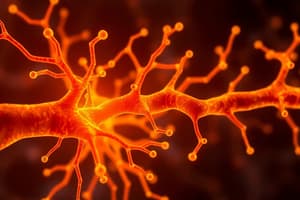Podcast
Questions and Answers
What is the primary outcome of long-term potentiation (LTP) on neuronal communication?
What is the primary outcome of long-term potentiation (LTP) on neuronal communication?
- Decreased responsiveness of neurons to neurotransmitters.
- Temporary reduction in synaptic strength.
- Increased efficiency of signal transmission across synapses. (correct)
- Elimination of unnecessary synaptic connections.
During the initial phase of NMDA-receptor dependent LTP, which receptors are primarily activated by glutamate?
During the initial phase of NMDA-receptor dependent LTP, which receptors are primarily activated by glutamate?
- AMPA receptors, leading to depolarization of the postsynaptic neuron. (correct)
- Dopamine receptors, modulating glutamate release from the presynaptic neuron.
- NMDA receptors, initiating calcium influx directly.
- GABA receptors, causing hyperpolarization and magnesium block removal.
What critical event directly enables calcium ions to enter the postsynaptic neuron through NMDA receptors during LTP induction?
What critical event directly enables calcium ions to enter the postsynaptic neuron through NMDA receptors during LTP induction?
- Inhibition of AMPA receptors by magnesium ions.
- Direct binding of glutamate to NMDA receptors bypassing the magnesium block.
- Hyperpolarization of the postsynaptic membrane.
- Depolarization of the postsynaptic membrane, removing the magnesium block. (correct)
How does the increased density of AMPA receptors in the postsynaptic membrane contribute to strengthened synaptic transmission after LTP induction?
How does the increased density of AMPA receptors in the postsynaptic membrane contribute to strengthened synaptic transmission after LTP induction?
Which long-term change within the neuron is associated with the lasting increase in synaptic strength observed in LTP?
Which long-term change within the neuron is associated with the lasting increase in synaptic strength observed in LTP?
Flashcards
Long-Term Potentiation (LTP)
Long-Term Potentiation (LTP)
A process that strengthens the connection between neurons, making them more likely to fire together in the future, due to repeated activity. This plays a key role in learning and memory.
NMDA-Receptor Dependent LTP
NMDA-Receptor Dependent LTP
A type of LTP that relies on the activation of NMDA receptors, which are normally blocked by Magnesium ions.
AMPA Receptor Activation
AMPA Receptor Activation
The initial step in NMDA-Dependent LTP, where glutamate released from the presynaptic neuron activates AMPA receptors, but not NMDA receptors.
Depolarization and NMDA Receptor Activation
Depolarization and NMDA Receptor Activation
Signup and view all the flashcards
Increased AMPA Receptor Density
Increased AMPA Receptor Density
Signup and view all the flashcards
Study Notes
Long-Term Potentiation (LTP)
- LTP is a process that strengthens synaptic connections between neurons due to frequent activation.
- LTP is thought to be a key mechanism for how the brain adapts to experience and contributes to learning and memory.
NMDA-Receptor Dependent LTP
- Glutamate release during frequent activation first activates AMPA receptors.
- NMDA receptors are located near AMPA receptors, but are blocked by magnesium ions at low levels of glutamate release.
- Frequent activation, through AMPA receptor stimulation, depolarizes the postsynaptic neuron, removing the magnesium block from NMDA receptors.
- This allows calcium ions to enter the NMDA receptor, triggering cellular processes that increase AMPA receptor density in the neuron's membrane.
- The new AMPA receptors are more responsive to glutamate, leading to increased sensitivity to glutamate and stronger synaptic transmission.
- Signals also travel back across the synapse to increase glutamate release, further strengthening the synapse.
Long-Term LTP Changes
- LTP is linked to gene transcription changes within the neuron, potentially leading to the production of new receptors and structural modifications.
- These changes contribute to the long-lasting nature of enhanced synaptic responsiveness associated with LTP.
Studying That Suits You
Use AI to generate personalized quizzes and flashcards to suit your learning preferences.




